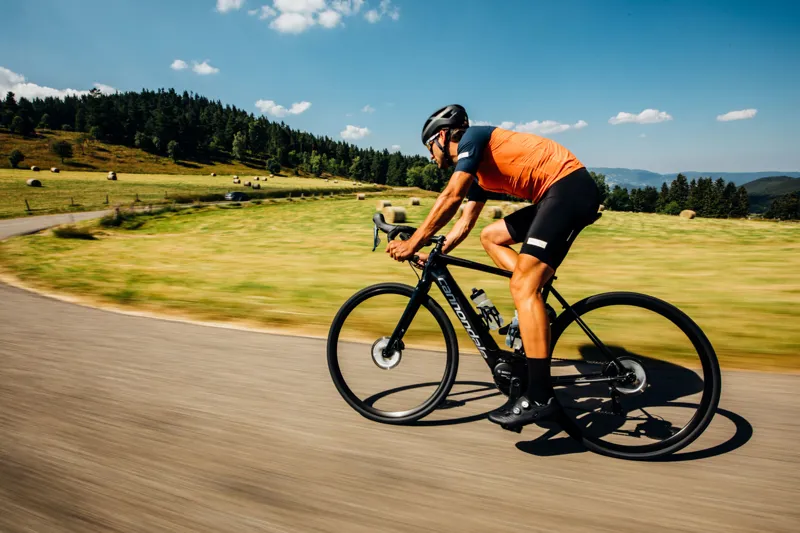
Chainstay length is a uniform 410mm for all frame sizes, while the bottom bracket drop starts out reasonably low (75mm) for the smallest frame sizes and decreases a little (73-70mm) for the larger ones. The geometry of the Synapse continues to be reasonably forgiving thanks to a taller and shorter front end compared to a typical race bike (e.g. The geometry of the Synapse was also re-visited, and amongst the changes is the addition of an extra small 44cm size, making for a total of seven frame sizes, as detailed in the table below: In addition, fender mounts were added to the fork legs and seatstays. An interchangeable cable port was also developed for the down tube of the frame that could accommodate mechanical, wired, and wireless groupsets. The Synapse provides internal routing for the brake hoses through the frame and fork. However, after encountering quality control issues during manufacturing, the company was forced to abandon the SystemBar for 2018. Designed to provide extra compliance for the front end of the bike, it was an obvious extension of Cannondale’s SAVE philosophy. The move to disc brakes also prompted Cannondale to increase tyre clearance: once a maximum of 28mm, the new Synapse can accommodate tyres up to 32mm wide.Īt the time of the launch last year, Cannondale was touting a new handlebar and stem system for the Synapse dubbed “SystemBar”. The most obvious change concerns the brakes: the 2018 Synapse is now dedicated solely to road disc brakes, and to this end, features flat-mounts for the disc callipers and 12mm thru-axles, front and rear. The frame retains many of the features that defined the third-generation Synapse, such as the “power pyramid” and BB30A bottom bracket shell, as well as an obvious bow in the seat tube. Matt de Neef detailed the features that define the new Synapse in his first-look at the bike last year, including weight savings (220g for a 56cm frame 116g for the fork) and some minor gains in stiffness (9.4%) at the head tube. Another was to increase the stiffness of the chassis in key areas, such as the head tube. In this regard, the company’s SuperSix EVO Disc served as an important benchmark, and one important goal was to shed a significant amount of weight from the frame and fork.

In developing the new Synapse, Cannondale’s engineers were intent on improving the comfort of the bike while adding back a measure of race-oriented performance. The second element, comprising the fork legs and stays, is meant to contend with small-to-medium bumps, while the final element, the seat tube and seatpost, soaks up the biggest hits. The system comprises three elements, starting with the carbon layup, which is designed to dissipate road buzz. However, it is the new Synapse where the system is at its most sophisticated, earning the moniker, SAVE PLUS. Now, many of Cannondale’s bikes feature SAVE, regardless of the materials used for construction. According to Cannondale, SAVE not only improves the comfort of the bike, but riders will also enjoy better control and handling. This concept, dubbed SAVE - Synapse Active Vibration Elimination - targets the design of the fork legs, seat- and chain-stays, and the seatpost so as to attenuate shock and vibration travelling through the chassis. During that time, Cannondale has dutifully refined the Synapse, building upon its original concept of micro-suspension for a road bike.

The Synapse was Cannondale’s first all-carbon frameset, and based on the model’s ongoing presence in the company’s road catalogue, it has found favour with buyers for over a decade. Now, our Australian tech editor, Matt Wikstrom, provides an in-depth review of the 2018 Synapse Hi-MOD to see if it lives up to Cannondale’s ambitious marketing claims.

Matt de Neef previewed the new Synapse range in July last year, and after spending a couple of days on the Hi-MOD version, was impressed with the amount of comfort the bike had to offer. The latest version, the fourth, builds upon the features introduced in 2014 to become a dedicated disc-brake offering with more tyre clearance for 2018. Cannondale unveiled the original Synapse in 2006, an all-carbon endurance-oriented frameset that has been steadily revised and updated since.


 0 kommentar(er)
0 kommentar(er)
